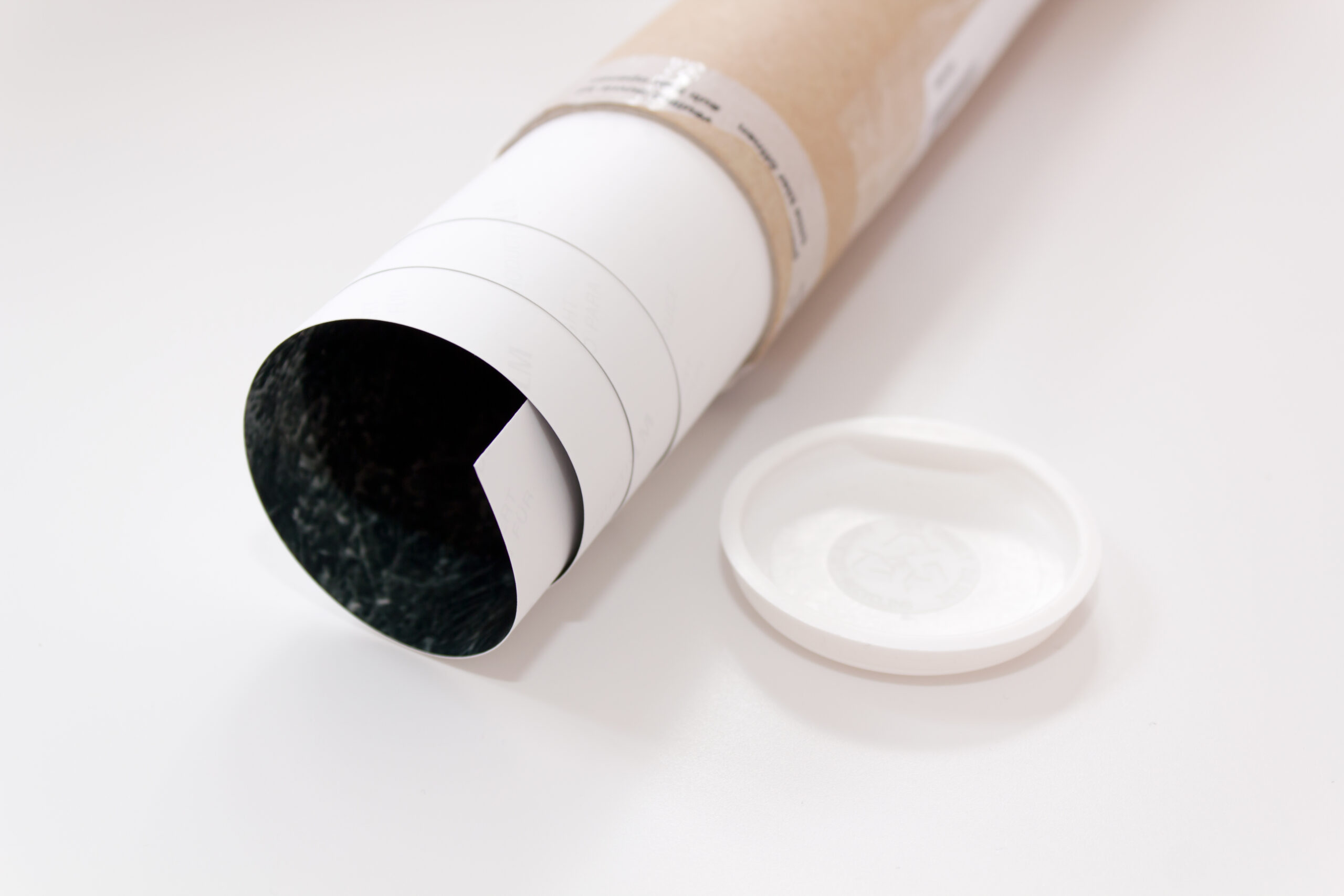Article takeaways
- Climate control is crucial for storing posters. Temperature should stay between 65-70°F, with humidity levels at 45-55% relative humidity to prevent warping, mold, and color fading in your poster collection.
- Store posters in acid-free tubes, tissue paper, sleeves, and backing boards to prevent paper degradation during long-term storage, and avoid using cardboard and PVC materials.
- While rolling posters for storage saves space in the short term, flat storage prevents permanent roll bends and creases that develop from extended rolled storage.
- Always wash and dry your hands thoroughly, use cotton or latex gloves, and clean posters with microfiber cloths before storing them to prevent oils, moisture, and debris from staining or tearing the poster paper.
- Climate control self-storage offers maximum protection for poster collection storage units, provides professional humidity control, pest management, security systems, and insurance coverage that home storage can’t match without dedicated effort.
From vintage posters for movies to art prints to blacklight posters to blown-up images of musicians and sports stars, posters are a craze that’s never gone out of style.
But as our poster collections grow, we’ve got less room to display them all at once. When not hung on the wall to impress our guests, our new and vintage posters need to be stashed and protected using proper storage solutions.
Posters are high on the list of things every man cave should have. Not only do our growing poster collections possess sentimental and artistic value, but vintage posters also hold financial value due to their exclusivity. And like any collectible item, posters need proper care and maintenance, especially when they’re tucked away.
Proper storage for posters requires a safe and secure space that is free from pests, moisture, and out of reach of damaging precipitation and harmful UV rays.
But we don’t all have a climate-controlled spare bedroom we can dedicate as a poster collection storage space.
If you don’t have the right storage space at home, fold marks or roll bends can destroy your posters. And moisture and humidity damage make basement or attic poster storage risky business.
If you store posters incorrectly in a storage unit, bugs or rodents can chew through your collection, and temperature fluctuations can warp them or cause mold and mildew growth.
This helpful guide will cover the best ways to store movie posters both at home and in self-storage, starting with the fundamentals. We’ll cover common threats and how to protect your poster collection against them.
We’ll review the storage materials needed, common poster storage mistakes, and how to choose between at-home poster storage and self-storage.
And last but not least, we’ll reveal how Storage.com’s storage unit locator tool can help you find a self-storage unit with all the amenities you need to keep your poster collection safe and sound.
Poster Storage Fundamentals: Common Poster Storage Threats and How to Defend Against Them

Let’s start our journey toward a safe and secure poster collection storage solution by reviewing the most common threats. As you’ll soon find out for yourself, the three most important defenses against them are proper location, proper location, and proper location.
Common Poster Storage Threats
For starters, UV light exposure is a poster and art print killer.
- UV light can destroy the natural hue of your poster paper, turning it from bright white to dingy yellow in no time.
- UV rays will also fade the inks and color scheme until it’s dull, mute, and if it gets bad enough, the image is less recognizable.
- Refrain from storing posters in a space that’s susceptible to frequent UV light exposure, be it natural sunlight or artificial ultraviolet lamps.
Next up on the list of poster storage threats is humidity and fluctuating temperatures. If your temperature is bouncing up and down, your poster paper and cardboard will expand and contract.
- Temperature fluctuations put stress on the posters, which can warp, wrinkle, and weaken their integrity.
- In terms of relative humidity levels, lower humidity levels will dry the paper out and even cause it to shrink. But too much humidity is just as bad, if not worse.
- As humidity rises, condensation will start forming on your poster paper, leading to mold and mildew growth.
- And unfortunately for your irreplacable vintage poster, once the mold sets in, there’s no way to bleach mold off of paper without ruining the poster for good.
Another threat to keep in mind is physical damage like creases, bends, rips, and tears. Folding, rolling incorrectly, or storing posters loose or under heavy items, or in a place where something can fall on top of them, risks physical damage that can’t be reversed.
- One rookie mistake that results in an early poster death is storing your poster in an acidic poster tube or flat sandwiched between acid dividers.
- Acidic paper, plastic, and cardboard materials will degrade the poster paper, especially if the poster is kept in the acidic material for long-term storage.
Last but not least, destructive to your posters are pests. And it doesn’t have to be an infestation.
- Bugs and rodents are more than happy to eat through your poster collection in small numbers as well.
- Some, like the bedbug and the silverfish, live in humid environments and prefer moist paper to dry paper.
- But other bugs, rodents, and even birds will shred through dry poster paper to build nests.
And even the bugs that aren’t interested in eating your posters may crawl around on them. Nobody wants to pull their vintage poster out of storage only to find that it’s discolored with smeared bug excretions.
Poster Protection Principles
Storing posters safely requires following a lot of the same advice we give for newspaper collection storage. For starters, always handle your posters correctly so you’re minimizing damage from the start.
- Before handling your posters, wash your hands with warm water, as warm as you can take without causing you pain.
- Warm running water can break up and rinse off any poster-staining sweat and oils from your fingers.
- Avoid using any soaps with chemicals, since the chemical residue can damage your poster paper as well.
- Be sure to thoroughly dry your hands before touching the poster. It only takes one drop of water to smear the ink or put a hole in the paper.
If you’re handling vintage posters that are rare or hard to replace, or if you just want to be extra careful, slip on a pair of clean and dry white gloves. Cotton and nylon gloves are what they use when framing art in museums.
But even a pair of unpowdered latex or vinyl gloves will keep your skin oils off the poster. Again, kitchen and medical-grade gloves can work as long as they’re unpowdered. Powered gloves will leave residue on your art.
As we mentioned above, temperature and humidity fluctuations are a frequent killer of paper products. So while a temperature-controlled storage space is a must, it still doesn’t guarantee consistent humidity levels.
Posters are high on the list of items that need climate-controlled storage, along with most other paper products, such as vinyl record albums, comic books, and business documents. In storage spaces with climate control, not only is the temperature kept at room temp year-round, but humidity levels stay in the safe zone 24/7.
At-Home Poster Collection Storage Solutions

It’s more than just their large size that makes storage for posters tricky; it’s also their flimsiness. No matter how small the posters are, you can’t just file them into a bookshelf or crate like comic books or magazines.
Storing rolled posters can buy you lots of freed-up space, and rolled posters can stay safe for a little while as long as they’re stored properly.
Rolled Poster Storage Techniques
Rolling up a poster and holding it in place with a rubber band is certainly the most affordable poster storage option. That said, it’s also the least protected.
The rubber band method of storage for posters exposes your poster to damaging UV light, moisture, and water, not to mention rips, tears, and wrinkles. And the rubber band itself can cause roll bends, creases, or even rips.
If you’ve ever bought a poster new or received one as a gift, it was likely rolled up and stored in a protective tube. While these tubes are a convenient way to transport a poster, most of them aren’t acid-free.
Acidic materials will erode your poster paper if the poster and the acidic material maintain contact for a long time. And that’s not to mention that these retail store poster tubes are typically made from cardboard.
Cardboard poster tubes won’t protect a poster from roll bends, blunt force impact, moisture damage/mildew, or pests.
Let’s consider what type of poster tube is the best way to store posters. Then we’ll look to roll up posters for storage.
Choose the best poster tube for storing posters
When it comes to storing posters rolled up in a poster tube, we suggest an acid-free plastic tube. If you’re looking for long-term poster collection storage, the space limitations of using your house for the storage likely prevent you from storing one poster per tube.
You’ll either need to roll multiple posters into a single tube, or you’ll need enough space to store as many tubes as you have posters.
The upside of these durable plastic poster tubes is that you can store them horizontally or vertically, which gives you an option if you’ve got some space to play with. Furthermore, poster tubes come in two shapes: round or square.
Square poster tubes have four flat walls, making them easier to stack when they’re horizontal. Round poster tubes don’t stack horizontally, but they do stand up vertically, say in the back of a closet full of clothes. And the smaller diameter of round poster tubes makes them easier to tuck out of sight, or under a bed, etc.
For an extra layer of protection, you’ll also want to have a poster storage sleeve on deck. You slip these sleeves over your rolled-up poster before you put it in the poster tube.
But again, don’t use an acidic or powdered sleeve or wrap. We suggest either polyethylene or a museum-grade archival product.
How to roll up posters for poster storage
Once you’ve decided on a poster tube shape, it’s time to roll the posters up properly. Wash and dry your hands thoroughly, and slip them into a pair of gentle, powder-free gloves for extra protection.
Be sure your posters are free from dust, dirt, or grime before you roll them up. It’s best to roll posters that are close in size together, so smaller posters don’t get folded up or creased inside larger ones. Stack all the posters you aim to store together into a neat pile, ensuring all the edges line up, and then roll them in unison.
Next, you slip the poster roll into one of those acid-free plastic sleeves you secured ahead of time. If the sleeve is longer than the poster roll, you fold the excess up and tape it, ensuring you tape the plastic sleeve to itself and not to the posters.
Now it’s time to put the posters into the poster tube. We suggest using a tube that has more space than the posters need and then putting bubble wrap or acid-free tissue paper in the bottom of the tube.
This extra padding stops the posters from bouncing up and down in there, which can ding and bend the edges of your posters. If the posters are still shifting around, you can either add more posters to the stack and re-roll them.
Choose a safe place to store posters at home
Now that you have your posters safely rolled up, sleeve protected, and fit into the plastic tube, it’s time to find a secure place. Remember, the storage space needs to be free from humidity, temperature fluctuations, and direct sunlight.
Think under the bed or in the back of a cool, dark closet. But avoid damp places like the basement, or hot and humid spaces like your garage.
At-home poster storage certainly has its benefits, such as not having to travel far when you want to browse or swap out the posters you have in storage. That said, there are also downsides. For starters, there are the obvious space constraints.
Those of you whose poster collection is still growing will have to constantly reorganize and will eventually run out of space. And if you do have the extra space, dedicating it to poster storage might not be realistic, depending on what else you need to keep at home.
There are also climate control challenges. Even if your home is air-conditioned and heated, that’s not climate control, as humidity and moisture control are still factors.
And finally, there’s the safety of your posters. If you spill a drink or miss a step, or if a bicycle helmet falls off the top shelf of your closet, your posters can get destroyed. The more trafficked a storage space is, the greater the chance of an accident. And we tend to spend a lot of time at home.
Now you’ve got a pretty good idea of how to store posters at home by rolling them up and putting them in poster tubes to save space. That said, you don’t want to store your posters rolled up for long-term storage, as they’ll end up with roll bends and creases.
On that note, let’s take a look at how to store posters outside of the home.
Using Self-Storage for Poster Collections

We’ve already covered the roll-up technique, which is great for at-home storage. That said, storing posters long term can result in roll bends and creases that last forever.
When it comes to using a storage unit as storage for posters, you’ve got more room to play with. This extra space means you can store your posters in what we call a flat stack, either sandwiched between acid-free paper, sturdy glass sheets, or mounted on acid-free backing boards.
Before we start mounting, sandwiching, and stacking, we need to choose the right storage unit. Then, we’ll examine how to prep posters for self-storage, how to build a safe flat stack, and which of the general self-storage practices matter most for storing posters.
But first, let’s dive into how you know when to choose self-storage for posters rather than storing them at home.
When to Consider Self-Storage
As we mentioned earlier, if your poster collection starts to outgrow your storage space, or if you plan on adding to it indefinitely, you might want to figure out a storage space outside your home.
Better to have a dedicated poster storage space elsewhere than to stuff your at-home poster storage full to the point of damaging your collection.
If you have rare, valuable, or vintage posters – or if your own doesn’t have controlled humidity levels – then you’ll probably want professional climate control.
- Climate-controlled spaces imply not only temperature-controlled storage units year-round but also humidity control.
- The storage facilities that house climate-controlled units employ humidity monitoring systems and dehumidifiers to keep humidity and moisture at a rate that’s not too dry, nor too wet.
- These middle-of-the-road humidity levels are perfect for storing posters and other paper goods.
If you plan on storing your posters for a long while and have long-term preservation goals, a storage unit is the move for you. Having your own off-site poster storage space allows you to organize it with shelving systems or storage containers specifically modified for keeping posters safe.
And finally, there are security enhancements and insurance benefits that come with renting a storage unit. For starters, lots of storage facilities use security cameras, coded electronic entry gate systems, motion sensors, and even onsite security personnel to keep the contents of your storage unit safe and under surveillance 24/7.
Facilities offer insurance policies that cover any belongings inside your storage unit up to a certain amount. Storage facilities with insurance programs often offer add-on plans if you need more coverage than the standard limits that come with your lease.
Preparing Posters for Self-Storage
You’ll want to clean your posters the same way you would if you were rolling them up. Wash and dry your hands thoroughly. You can always wear thin cotton or powder-free latex gloves to avoid getting dirt, sweat, and skin oils onto the posters as you pack them.
Use a dry microfiber cloth and gently sweep away any dust or dirt particles from the posters before you get started.
Don’t apply pressure or you’ll grind the particles into the poster, and the pressure itself risks wrinkling or even tearing them. Instead, use the cloth like a duster, and dust the posters with as little contact as possible.
We suggest getting our acid-free backing boards ready to provide stability for the process. Putting your clean posters on mounting boards prevents folding and bending damage, and also guards the posters against blunt force impact.
Flat Storage For Posters
The best way to store posters in a storage unit long term is to store them flat. Flat storage is a safe bet in terms of long-term poster storage solutions, provided you follow these tips:
Choosing the right storage unit for flat poster storage
Now you understand the common factors that threaten posters in storage. You’re also aware of the ins and outs of storing posters correctly. All of this knowledge will guide you when it comes time to choose the ideal storage unit for poster collections.
For starters, a climate-controlled storage unit is a necessity. We’ll dedicate a whole section to this later, but for now, we can say that extreme temperature changes, moisture, pests, and humidity levels that are either too high or too low are all on the list of primary threats to your poster’s condition.
You also want to choose the correct storage unit size. If you’re only using the unit for poster collection storage, then the size of your collection dictates the size you need.
| Unit Size/Features | How it Helps with Storing Posters |
|---|---|
| 5×5 Storage Unit | Easily affordable, but your poster storage methods will have to be pretty straightforward. |
| 5×10 Storage Unit | Might be more your speed if you want a storage unit that leaves your collection with some room to grow, or lets you get creative with your poster storage solutions |
| 24-Hour Access | If you’re a night owl or an early riser who may need to access your storage unit at all hours of the night, you’ll likely want to find a storage unit with a coded entry gate that gives you 24-hour access to your poster collection. |
| Enhanced Security Features | If you’re storing one-of-a-kind or vintage posters that are valuable, you’ll probably want to keep your collection in a storage facility with enhanced security features like 24/7 camera surveillance, on-site management, and security personnel. |
There’s also height and weight to consider. If you have a large poster collection, you have to consider how high your stack is going to be. Storage units with higher ceilings will let you stack your poster collection 6 feet tall, but you’d also have to consider weight.
Keep in mind that we’re going to be putting a divider between posters for protection. If you’re using reinforced glass sheet, mounting board, or heavy foam board, the weight of your flat poster stack needs to be on solid ground.
Let’s talk more about the poster protection materials we’ll need for flat storage.
Gather your flat poster storage supplies
Storing posters flat means more than just shoving your posters in that old cardboard box your kitchen table came in. At the very least, insert some acid-free plastic sleeves or acid-free tissue paper between your posters to keep them from rubbing against each other or sticking together.
Flat glass sheets or picture frames work well too, since they keep the posters pressed together. We suggest slipping some acid-free tissues between the glass sheets to avoid glass-on-glass contact.
Mylar sleeves are another asset for flat poster storage. Mylar sleeves are the sleeves people keep collectible trading cards in. They come in poster sizes, too, and are one of the more rugged options, allowing you to drop your stack carefree without worrying about poster scuffs or broken glass.
You’ll find some poster collectors storing their posters on backer board, slipping both the board and poster into the sleeve. Others stick to the mylar sleeves and don’t worry about the backer board, as the sleeve offers plenty of protection on its own.
We suggest using a sleeve and a backing board since, if you follow our guidelines, you’ll be organizing your sandwiched posters into small stacks and putting them into acid-free plastic boxes.
A storage portfolio is another simple and effective poster storage solution for flat storage. Storage portfolios are used to transport artwork. They look like a large folder with a briefcase handle attached.
With posters, we still suggest you keep the portfolio case flat on its back instead of trying to store it upright like a book, or your posters will sag and bend. But you can fit multiple posters into a portfolio case, though we suggest slipping some acid-free tissue paper between each poster.
And when it comes time to move your poster collection from storage, simply grab the handle of your storage portfolio case and you’re on your way.
PRO TIP: Avoid using wooden mounting boards as dividers in your posters.
- Wood can leech onto your posters, warp from heat, and bend them. Plus, wood holds moisture and can cause mildew to form on the poster paper.
- Also, avoid sheet metal dividers, which oxidize.
- Once it does, the rusty residue can rub off on your goods.
- Acid-free plastic mounting board is your best bet.
We also suggest keeping large, acid-free archival storage boxes on deck. You can stack a handful of mounted posters in each box, rather than just piling your entire collection of posters in a single flat stack.
If you’ve chosen one of the non-glass options, the next step is to safely stack your posters. Before we get into just how to do that, let’s give our glass stackers a quick look at how to care for and use glass for flat poster storage without breaking it.
Glass care when using glass sheets when storing posters in flat storage stacks
You’ll need to clean the glass before pressing your posters against it. Distilled water works best unless there’s grime or sticky streaks.
If you need to use a glass cleaner, use a safe, natural, chemical-free cleaning solution, as the chemical residue can damage your posters. Be sure you thoroughly dry your glass panels before slipping your poster between them.
We suggest blocking your storage unit from any UV light intrusion. Glass magnifies UV light, making it even more effective at damaging your posters while they’re in storage.
If you use thin glass sheets, you won’t be able to stack your posters without shattering the glass. If you’re using reinforced glass, you can stack it, but reinforced glass is heavy, so don’t stack it too high.
Sandwiching and boxing your posters for flat storage
Once you’ve chosen a flat storage space and gathered your materials, it’s time to form a proper stack. Rushing through this process can leave your posters uneven, or some flatter than others. Once you start stacking other posters on top of them, you risk forming permanent creases on the folded posters.
Stack one poster at a time. First, lay down the divider of your choice. If it’s an acid-free plastic sleeve, carefully slip the poster and backing board inside it. If your divider is an envelope or portfolio shape, you simply stack the poster and mounting board flat on top of the divider while it’s open, and then close it around the poster.
If you’re sandwiching the board-mounted poster between two glass sheet dividers or something similar, lay it on one, and cover it with a second one.
Regardless of the divider you use, ensure the poster is completely flat. Repeat this step for each poster until you’ve got a stack of about 5 -10 posters, as many as you can fit into your storage box. Fill one box at a time, seal it, and move on to the next stack of posters.
Storage Solutions for Storing Posters in Self-Storage
These classic storage solutions are among the best ways to store posters in a storage unit.
- Stack your posters and organize them into boxes based on the type of poster. Then, label the box accordingly.
- For example, you can have a box of car posters, a box of movie posters, one for art prints, etc.
- Or, if your entire poster collection is comprised of vintage posters of old movies, you can organize them based on movie genre.
- Install some metal shelving units in your storage unit and organize your boxes of poster stacks into separate stacks on top of the shelves.
- As long as you’re not using thin, breakable glass, you can stack your poster collections as high as you want using the sandwich method without worrying about damaging them.
- But remember, if you need to grab a specific poster or poster box from the stack, you’ll have to pull all the other posters off to get to it. Don’t ever try to pull a poster out from the middle of the stack.
- If you need to mobilize any of your poster stacks for conventions, shows, or to swap out the posters at home, keep a few storage carts in your poster storage unit and put some boxed poster stacks on them.
- That way, you can roll the cart out to your car and back when it comes time to mobilize your poster collections.
With shelves, you can organize your boxes, create a labeling system, and make an inventory guide so you can find the poster you need right away.
We suggest stacking your posters so that the ones you need to access less frequently are on the bottom of the stack, and the ones you may need to browse through sooner are at the top. Or you can put all the less frequently accessed posters on he top shelf and save the easier to reach shelves for the posters you browse often.
Archival Products: The Ideal Poster Storage Supplies

We covered some of our favorite poster storage supplies as we went, but let’s review the primary materials used, starting with the essential archival storage supplies.
Archival storage tubes and tissue papers are great assets for poster storage because they’re all acid-free. Acid-free archival products are especially important for long-term poster storage, as they preserve the quality of the poster paper they’re in direct contact with.
Here’s a list of some of our favorite archival products, with a brief explanation of each:
- Archival Tubes: If you’re rolling your posters up for short-term storage, an archival poster tube is your tube of choice. These are made from durable, acid-free plastic that can protect your posters from getting crushed without damaging the paper quality.
- Acid-Free Tissue Paper: Acid-free tissues are great for putting between glass sheets when latticing. They’re also the ideal product for stuffing into your poster tubes to reduce the slack nd hold the rolled posters in place.
- Archival Storage Sleeves: These are museum-grade polyester sleeves that protect your posters while they’re in long-term storage. Archival storage sleeves are clear, allowing you to see the poster through the sleeve.
- Acid-Free Storage Boxes: Archival storage boxes are used by museums to store art and historical documents that are sensitive to UV light, dust, humidity, moisture, and pests. Since your posters are vulnerable to all the same hazards, these acid-free containers are perfect for protecting vintage posters or any other paper items. Throw a silica gel back in the box for an extra layer of protection against moisture and mildew.
- Climate Control and Monitoring Tools: In addition to your thermostat and temperature control systems, such as heaters and air conditioning units, you also need to control the moisture in the air. We already mentioned silica gel packets in your storage containers. Take it up a notch by putting a dehumidifier in the space. But remember, too dry can be as bad for your posters as too wet. You’ll also want a humidity level monitor system that shuts the dehumidifier off before it overcompensates, ensuring your humidity levels stay within the ideal range.
All of these items are easy to order online, both on archival storage supply chains and at large online retailers, as long as you know what to search for. Using the terms we used above should bring up some pretty solid search results.
If you’d prefer to shop locally, you can check out art supply stores and office supply stores in your area. Archival products are often used to store art pieces and office documents for long-term preservation. A knowledgeable art or office supply retailer should know what you’re asking for and be able to lead you in the right direction.
There are some DIY solutions you can employ to save some money, as museum-grade archival storage supplies aren’t always the most affordable options. That said, any alternative you try should be acid-free and as close to the archival products in quality and grade as you can afford.
Climate Control and Environmental Protection
We’ve mentioned climate control a few times now, but let’s break down exactly what climate control storage entails. Your poster storage space should be kept at a consistent temperature, as fluctuations between extreme cold and hot can cause your paper-based collectibles to expand and contract.
That said, it’s not enough to keep the space you’re using for storing posters at any old temperature, no matter how consistent. The ideal poster storage temperature range is between 65 and 70°F.
- Extreme heat can warp your posters and cause the mounting boards to expand.
- Extreme heat is a threat to poster collections stored in the Southwest, Southeast, and most of the Midwest.
- Extreme cold has the opposite effect.
- Your posters can contract or even freeze. If your posters retain any moisture once the ice thaws, they’ll get wrinkled and may even start to grow mold
- Extreme cold is most likely to damage posters stored in the Pacific Northwest, the Midwest, most of the Rocky Mountain region, East North Central near the Great Lakes, New England, and the Mid-Atlantic states.
- Both hot and cold extreme temperatures can cause your poster colors to fade.
Extreme temperatures make at-home poster storage a bit tricky, as you might not always want to keep your poster storage space this tightly regulated. But remember, there’s a difference between climate-controlled storage and non-climate-controlled storage as well. Even if you take our advice and book a storage unit for your poster collection storage space, be sure you nab a climate-controlled unit.
We also discussed the impact humidity can have on your posters while they’re in storage. We mentioned that humidity levels need to be in the mean range, not moist, but also not too dry. The ideal humidity level range for storing posters is between 45% 55% relative humidity (RH).
- High humidity levels quickly turn any storage space into a breeding ground for mold, mildew, pests, and bacteria.
- But if a storage space is too dry, the posters can get brittle and start to crack.
- Prolonged exposure to extreme humidity or harsh dryness will ruin your paper-based collectibles.
It’s even harder to control the humidity levels of an at-home poster storage space than it is to control the temperature, as most people don’t have elaborate humidity monitoring and management systems in place. That’s where climate-controlled storage units come in.
Climate-controlled storage implies both humidity and temperature-controlled storage. Storage facilities guarantee climate control by managing the entire indoor wing of units with humidity level monitoring systems, heaters, and air conditioning.
In short, climate-controlled storage units are almost always indoor. With stable temperatures and humidity levels, your poster collection will be protected from damage throughout long-term storage.
Common Poster Storage Mistakes and the Best Ways to Store Posters

Now let’s review the most common poster storage mistakes and how to avoid them by applying some of the best storage practices:
| Don’ts | Do’s |
|---|---|
| Choosing a non-climate-controlled storage unit, storing your posters at home in a garage, basement, attic, or shed, is a common poster storage mistake that results in an early poster death. | You’ve probably figured out by now that the best way to store posters is in a climate-controlled space. |
| Next on the list is using acidic or otherwise harmful materials, such as using cardboard dividers or PVC pipe tubes as storage for posters. | The best way to store posters is in acid-free paper or acid-free plastic, in a cool, dark space. |
| Storing too many posters in the same space, especially when they’re all rolled together, is another common mistake that can result in permanent roll bends. A lack of organization can lead to posters being misplaced. And once you forget that box in the corner is full of posters, you’re liable to drop a heavy box on top of it, crushing the posters inside. | The best way to store posters and avoid this is to start with plenty of storage space and to keep that space organized and your posters labeled. |
| The last item on our list of common mistakes is neglecting to check in on your poster collection storage space. A lack of mentoring and the room’s climate can lead to temperature, humidity, or water-related damage. And failing to conduct routine storage maintenance could let pests make themselves at home. | A solid poster storage inventory system and routine poster checkups and storage space maintenance can catch environmental threats at the earliest stages, or even prevent them from happening altogether. |
A climate-controlled storage unit protects your poster collection from moisture, humidity, water, and pest damage. Using self-storage for movie poster storage gives you enough space to install an organizational system that prevents neglect and overcrowding.
Making the Poster Collection Storage Decision: Home vs. Self Storage
There are a few deciding factors you can use to make the decision between storing your poster at home or in self-storage.
- How big is your poster collection? If your poster collection is comprised of fewer than 5 posters, home storage could be a cheap and easy storage solution. But if your poster collection is more than 50 posters strong, self-storage is probably the safer, more efficient choice.
- What type of posters are you storing? Renting a climate-controlled storage unit may seem like an expensive option. But if your poster collection consists of 75 vintage posters that can’t be replaced, the long-term preservation is worth the low monthly cost of renting a unit. A self-storage unit gives you the space to store your posters flat on a shelf, preserving their shape. If you’re storing your poster collection at home, you’ll likely have to roll them up. Leave them rolled up for too long, and they’ll be warped and bent for good.
- What’s the climate of your house like? There are clear advantages to professional climate control setups employed by storage facilities. Rarely do we have the time or resources to keep the humidity and temperature levels of our home year-round, and who wants to live in a 70-degree house all the time?
And you’re ot only paying for professional climate control, your monthly storage unit rent often includes insurance coverage, expert-level pest control, and professional security amenities as well.
Of course, if you do decide to use self-storage as your designated space for storing posters, not just any storage unit will do. You’ll have to find a climate-controlled storage unit near you that’s the right size and has all the other specific amenities you need.
That’s where we come in.
The Best Way to Store Posters: How Storage.com Can Help
We’re no stranger to the connection that forms between collectors and their collectibles. Whether you’re restoring rare vintage posters or modern movie posters, the emotional connection is part of the whole reason why we foster a collection in the first place.
That’s why it’s extra important to store your posters properly. Use acid-free plastic and paper supplies, and museum-grade archive products if you can swing it.
When it comes to framing your posters, UV-filtering glass sheet or acrylic archival matting can prevent the yellowing and wrinkling that light exposure causes to posters on display.
But when you’re storing posters, the storage location impacts the posters’ condition more than anything. We suggest a climate-controlled self-storage unit for large collections and for long-term storage.
Storing your posters rolled up at home is convenient in the short term, but keeping them rolled and storing them in crowded spaces can damage your precious poster collection.
Plus, the predictable humidity and temperature levels a climate-controlled storage unit provides ensure your posters won’t shrivel in the heat or grow mold in humidity.
But not all storage units are created equal. If you rent one that’s too big for your poster storage needs, you’re paying for space you don’t use. And how can you be sure the unit you’re pricing online is climate-controlled, or even in your zip code?
Don’t fret – Storage.com can help.
Just punch your zip code into our signature storage search tool to find storage facilities near you with available units. Our special amenity filters let you limit the search results with any features you need, including climate control and specific unit sizes.
Whether your poster collection is expanding or you need enough space to organize your posters into flat stacks so they don’t warp, let’s start browsing for the ideal poster storage unit!




![The Ultimate RV Packing List & Checklist [Printable]](https://www.storage.com/blog/wp-content/uploads/2025/08/shutterstock_2490234073-e1756329334567.jpg)

